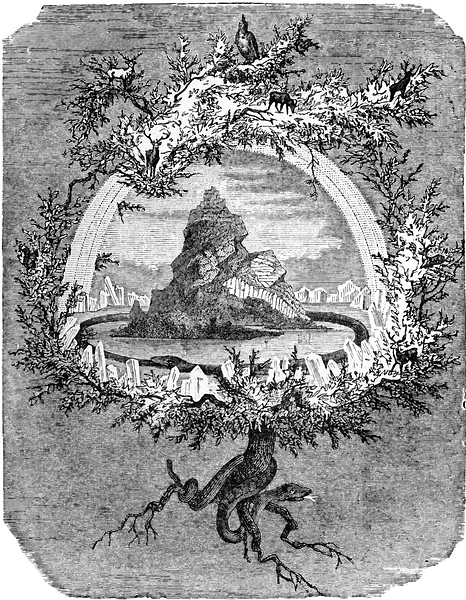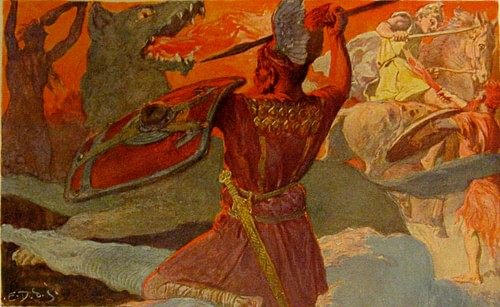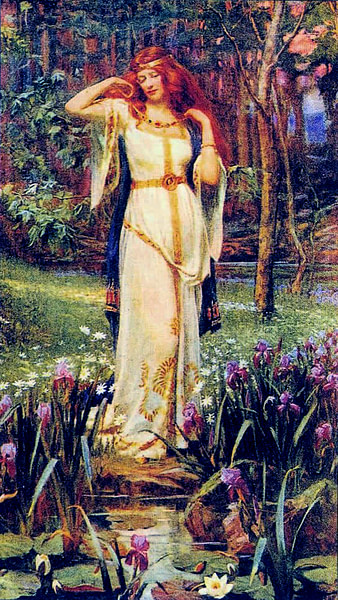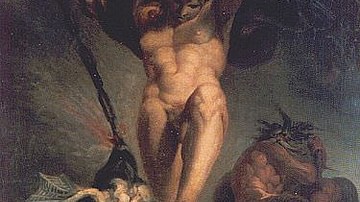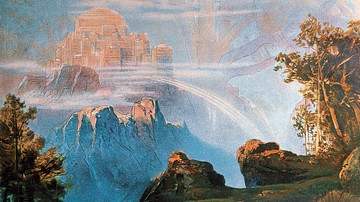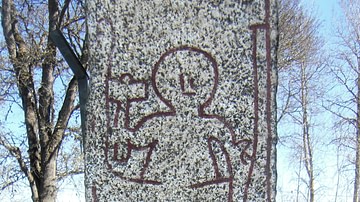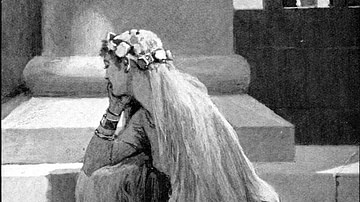Norse cosmology divided the universe into nine realms. The center of the universe was the great world-tree Yggdrasil and the nine realms either spread out from the tree or existed in levels stretching from the roots down and, marginally, side-to-side.
Earlier Norse works (known as Eddic and Skaldic poetry) assume a knowledge of the cosmology and do not bother much with descriptions of locations or, in some cases, even specifics of what the realms were like and, because of this – and the fact that Norse religion had no written scripture – some of the realms are less clear than others.
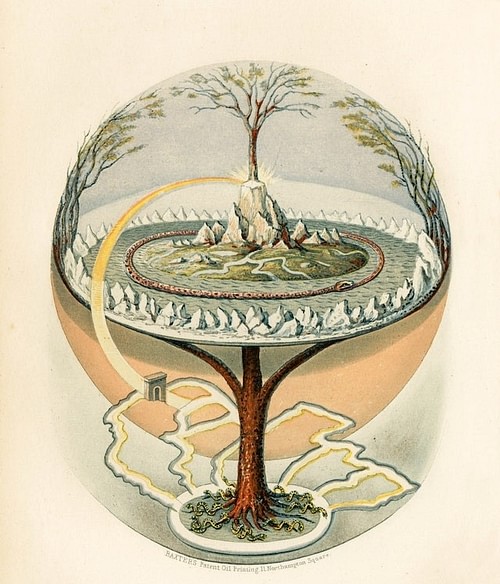
Norse religious belief was characterized by the concept of síður (meaning “custom” or “habit”) in that it was fully integrated into the lives of the people. One would not attend service in anything like a church but would observe worship of the gods in one's own home, in a clearing in the woods, or in some sacred place of chthonic power. Even though there is evidence that temples to the gods existed, there is no record of what services or rituals performed there were like.
The Icelandic mythographer Snorri Sturluson (1179-1241 CE) finally wrote down the great Norse sagas but was a Christian writing for a Christian audience and so altered the original material. Even the Saga of the Volsungs, regularly cited by scholars as embodying “authentic” Norse beliefs, was finally set down in writing only around 1250 CE by an anonymous Christian scribe (Crawford, ix). These later works certainly point to much older and authentic Norse tales but are colored by the Christian context in which they were written. The concept of the afterlife realm of Hel, for example, is thought by scholars to be a wholly Christian concept added to Norse cosmology after Scandinavia was introduced to the new religion even though some realm known as Niflhel exists in earlier literature.
The original nine realms of the Norse universe were probably:
- Asgard – Realm of the Aesir
- Alfheim – Realm of the Bright Elves
- Jotunheim – Realm of the Giants
- Midgard – Realm of the Humans
- Muspelheim/Muspell – A fire-giant or the forces of chaos or their realm
- Nidavellir – Realm of the Dwarves
- Niflheim – Realm of Ice and Mist possibly with lower realm of Niflhel
- Svartalfheim – Realm of the Black Elves
- Vanaheim – Realm of the Vanir
After Snorri's work, the nine realms changed as he seems to have confused the black elves with the dwarves and merged Nidavellir with Svartalfheim as a single realm while adding the concept of Hel as the most populous realm of the afterlife and making other changes. The nine realms according to Snorri Sturluson and those who wrote after him are:
- Asgard – Realm of the Aesir, joined to Midgard by the rainbow bridge Bifrost
- Alfheim – Realm of the Elves
- Hel – Realm of those who died of illness or old age and then of most people
- Jotunheim – Realm of the Giants and Frost Giants
- Midgard – Realm of the Humans between Asgard and Jotunheim
- Muspelheim – Realm of Fire, the fire-giant Surtr, and Surtr's forces of chaos
- Nidavellir/Svartalfheim – Realm of the Dwarves beneath the earth
- Niflheim – Realm of Ice, Snow, and Mist near Muspelheim
- Vanaheim – Realm of the Vanir
These nine most likely would not all be recognized by a pre-Christian Scandinavian but they are the clearest depiction of the Nine Realms available in the present day. The same is true of the story of the creation of the world and human beings which may have been quite different when the Norse religion was a living, dynamic faith.
The World Tree & Creation
In the time before time, when nothing existed, there was only the tree Yggdrasil and the void. No mention is made anywhere of who or what created the great tree of the world but all nine realms existed in and around its roots. It seems to have grown from the misty void of Ginnungagap which was bordered on one side by fiery Muspelheim and on the other by icy Niflheim. At some point, the fires of Muspelheim began to melt the ice of Niflheim and two entities emerged from the realm of mist: Ymir the giant and Audhumla the cow.
Audhumla drew sustenance from licking the ice and soon uncovered Buri, the ancestor of the gods. Buri had a son (no mention is made of how) named Borr who mated with the giantess Bestla (who also appears from nowhere). Bestla gave birth to the first of the gods: Odin, Vili, and Ve. While this was going on, Ymir gave birth to the giants through the process of autogamy (self-fertilization). While he sleeps, a male and female are born from his left armpit and a son comes from his legs; these will be the ancestors of the giants.
Odin and his brothers kill Ymir and the giants are all drowned in his gushing blood except for Bergelmir and his wife who escape on a raft and will produce all the later giants who will be the sworn enemies of the gods. After Ymir is dead, Odin, Vili, and Ve drag his body to the void of Ginnungagap where they create the world from his corpse and, later, the first man (Ask) and first woman (Embla) from two trees. At this same time, it seems, the nine realms were also created.
Asgard
Originally, it is thought, Asgard was a part of the world of humans but Snorri places it in the heavens, connected to Midgard by Bifrost, the rainbow bridge. Asgard is the home of the Aesir, the majority of the Norse pantheon who warred with other gods known as the Vanir, made peace, and exchanged hostages to maintain that peace. Therefore, even though Asgard is primarily the home of the Aesir, there are Vanir who live there just as there are Aesir in Vanaheim.
The best-known gods of the Norse pantheon are Aesir or live in Asgard: Odin, Thor, Loki, and Baldr. Asgard is depicted as a celestial city of high towers surrounded by a great wall. Odin's famous hall of Valhalla, where his throne may have been located, is in Asgard. However, a place-name or object, Hildskjalf, is mentioned from which Odin can gaze out over the entire world and it is unclear whether this is his royal hall (separate from Valhalla) or his throne.
Alfheim
Alfheim also exists in the heavens, not far from Asgard, and was the home of the light (or bright) elves and, after Snorri, all the elves. It was presided over by the Vanir god Freyr who was one of the hostages sent from Vanaheim to Asgard at the conclusion of the war. The elves are magical beings, bright and beautiful, who inspired the arts, music, and creativity in general.
Scholar John Lindow (and others) has noted that Alfheimar was the geographic locale between the mouths of the rivers Gota and Glom at the border between Sweden and Norway and that people from this region were considered “fairer” than those in other places. The mythological Alfheim is therefore thought to be inspired by this region but this claim has been challenged. The realm is not described clearly in Norse literature but, owing to the nature of the elves, is thought to be quite lovely.
Hel
Hel (sometimes known as Helheim) is a dark, gloomy realm presided over by Hel, daughter of Loki, and sister of the Midgard serpent and Fenrir the wolf. When Loki's children were born, Odin knew they would cause trouble and so sought to place each one where it would do the least harm. He placed the Midgard serpent in the seas which surround the world, had Fenrir chained up, and threw Hel into a dark realm beneath the roots of Yggdrasil. This realm was then surrounded by a wall with only one gate and could only be reached by traveling downhill on a long, long path (known as Helveg – the way or road to Hel) and crossing a dangerous river of weapons.
Hel herself is depicted as a giantess, glum and brooding, and not at all like the character of Hela in the Marvel film Thor: Ragnarok (2017) played by Cate Blanchett. For reasons which are unclear, her realm became associated with the souls of the dead which did not die in battle and, initially at least, those who died from disease or old age. In time, it became the most populous realm of the dead and most people who died were thought to travel to Hel's dark realm where they wandered in a kind of twilight but, otherwise, did more or less what they had done while alive. Determining who went to Hel's realm or why is not easy as the great hero-god Baldr, among others, is said to have gone to Hel when, considering his status, he should have gone to Valhalla.
Jotunheim
Jotunheim (sometimes referred to as Utgard) is the realm of the giants and Frost Giants and is located near both Asgard and Midgard. Jotunheim/Utgard was considered beyond the realm of order, a primordial place of chaos, magic, and untamed wilderness. Loki, the trickster god of mischief, came from Jotunheim but lived in Asgard. Jotunheim was considered best avoided but there are a number of tales involving gods of Asgard purposefully traveling there.
It was separated from Asgard by the river Iving, which never froze and was difficult to cross, but Odin traveled to Jotunheim to Mimir's well of wisdom and Thor also went there to the stronghold of the giant Utgarda-Loki. Anything could happen to a person in Jotunheim as the tale of Thor and Utgarda-Loki makes clear: nothing Thor experiences on his journey is what it appears to be and, at the end of the story, the stronghold and everyone in it disappears.
Midgard
The realm of human beings was first populated by Ask and Embla, from whom all other people are descended. After Odin, Veli, and Ve kill Ymir and create the world, they are walking along by the sea and find two trees, an Ash and an Elm. They create the first man from the Ash tree and the woman from the Elm. They understand, however, that these creatures are helpless and easy prey for the giants and so create Midgard to protect them. In the Gylfafinning section of the Prose Edda, the story-teller High describes Midgard:
It is [the earth] circular around the edge and surrounding it lies the deep sea. On these ocean coasts, the sons of Bor [Odin, Vili, and Ve] gave land to the clans of the giants to live on. But further inland they built a fortress wall around the world to protect against the hostility of the giants. As material for the wall, they used the eyelashes of the giant Ymir and called this stronghold Midgard. (17)
After humans are created, the gods create Asgard with its high walls for protection and are then assumed to have made the animals in Midgard and the rainbow bridge.
Muspelheim
Muspelheim is the primordial realm of fire, according to Snorri, which was instrumental in the creation of the world. The Fire-Giant Surtr lives in this realm and will emerge at Ragnarok, the twilight of the gods, to destroy Asgard and everything else. Scholars in the modern day, however, disagree with Snorri's interpretation and believe that Muspell was originally a giant from a fiery world whose only function in original Norse mythology was the part he would play at Ragnarok.
John Lindow, for example, notes how, “in eddic poetry, Muspell is associated with groups, Muspell's peoples and Muspell's sons. Both refer to the hordes of evil beings that will invade the world at Ragnarok” (234). Simek agrees with this, citing Muspell as most likely the name for a giant and meaning roughly “the end of the world” (223). As with many of the original Norse concepts, however, Snorri's interpretation changed how Muspell or Muspelheim was originally viewed and for the past few hundred years it has been understood as a place of fire, not an entity.
Nidavellir/Svartalfheim
The realm of Nidavellier/Svartalfheim was below Midgard, deep in the earth, and the home of the dwarves who toiled there at their forges. It is a dark, smoky, place lit only by the fires from the forge and the torches on the walls. The gods seem to have decreed the realm of the dwarves based on their origin as given by Snorri in the Gylfafinning:
Next, the gods took their places on their thrones. They issued their judgments and remembered where the dwarves had come to life in the soil under the earth, like maggots in flesh. The dwarves emerged first, finding life in Ymir's flesh. They were maggots at that time, but by a decision of the gods they acquired human understanding and assumed the likeness of men, living in the earth and the rocks. (22)
The dwarves were associated with craftsmanship and magic. They created Thor's hammer Mjolnir and Odin's spear and well as the god Frey's magic ship which can be folded up and carried in his pocket. They are also responsible for the Mead of Poetry which Odin steals from the giants and gives to the gods who then inspire poets, through drink, to create their verse.
Niflheim
Niflheim, along with Muspelheim, is the oldest of the nine realms, the primordial land of ice, mist, and snow, from whence all life began. Snorri equates Niflheim with Niflhel which gave rise to his understanding of Niflheim as the location of Hel's realm. If Niflhel did exist in Norse cosmology prior to Christianity – as it seems to have - there is no mention of it in Niflheim and it was probably an abode of the dead comparable to Tartarus in Greek mythology or the later depictions of Hel: a dark, dreary place where the souls of the dead are confined. It may have been located beneath Niflheim.
Niflheim, however, has nothing to do with the realm of the dead per se. It is a cold and misty realm where no one lives, not even the Frost Giants. Odin is said to have thrown Hel into Niflheim and to have then given her power over the dead and the lives of those in the Nine Realms but it is thought that she would have passed through Niflheim and into Niflhel (which just means “dark realm of Hel”) where she then ruled.
Vanaheim
Vanaheim is the home of the Vanir, the other family of Norse gods, who were associated with fertility and magic. The Aesir went to war with the Vanir but precisely why is unclear. It may be the war was fought over various practices of the Vanir which the Aesir considered unacceptable such as allowing incest and practicing a kind of magic the Aesir thought dishonorable. Whatever the war was about, it was concluded by a peace treaty in which hostages were exchanged and the Vanir sea god Njord and his two children Freyr and Frejya went to live in Asgard.
No descriptions are given for Vanaheim but it is assumed to be a fertile and pleasant realm of magic and light. Simek writes, “The Vanir are in particular fertility gods who were called upon for good harvests, sun, rain, and good winds especially by the agrarian population, and for favorable weather conditions by the seafarers and fishermen” (350). Freyja – one of the most popular Norse deities - presided over her own realm of the dead somewhere in Asgard called Folkvangr (“Field of the People”) which was quite probably as pleasant as Vanaheim, her home realm.
Conclusion
All these nine realms coexisted, operating together, and would do so until the day of Ragnarok. Independent of the Nine Realms, and living together in the roots of Yggdrasil, were the Norns – the fates – who weave the destinies of human beings and the gods. Like the Three Fates of ancient Greek belief or the Seven Hathors or god of fate Shay (Shai) in the religion of ancient Egypt, the decisions of the Norns were final and no one could appeal them. The world and all nine realms would be destroyed and there was nothing anyone could do about that.
Ragnarok would begin with a hard winter of ice and snow and then the arrival of Surtr the Fire Giant who would consume the world in flame at the same time that the Midgard serpent breaks free, churning the waters around Midgard and sinking the earth while, simultaneously, the great wolf Fenrir snaps his chains and devours the sun. The rainbow bridge Bifrost cracks and falls as Yggdrasil shakes and the gods arrange themselves for the final battle to save the ordered world they have built from the forces of chaos. The gods will lose, and they know that going into battle, but a handful will survive the final conflict and a new world and new order of realms would eventually rise from the ashes of the old.
This was the vision of the Norse religion: one could be certain of death and the loss of all one loved but, afterwards, there was something else. This vision was true for the individual soul as well as the earth itself and everything in it. What that something else might be was a mystery – there are no references to what the new world might be like after Ragnarok – but there was always the hope of a new beginning and the continuance of life in other realms after loss and death.
